QBARS - v34n2 Robin Hill Azaleas
Robin Hill Azaleas
By Matthew A. Nosal, Wading River, N.Y.
Reprinted from Mass. Chapter Newsletter "The Rosebay"
As the days of May come to an end, the azalea collector is suddenly faced with a dilemma; the garden that was a riot of color throughout most of May is suddenly facing a void, since most of the azaleas are finishing their blooming season. There is still some bloom to look forward to, however, since some of the late Glen Dale and Gable hybrids are just starting to flower, and in mid June the Macrantha hybrids will burst forth with flowers. There are also Satsuki hybrids that hold promise for June bloom..
Ah, the Satsuki hybrids! What promise they have for the azalea lover; large flowers, unusual color patterns, beautiful foliage and growth habit, late blooming to extend the season into June. But mostly, they just promise, since they are not reliably hardy north of Philadelphia. They are capable of providing some color in the New York area, but many gardeners find them too much trouble to consider seriously. If you have ever tried to grow Satsuki hybrids and found them disappointing, then explore the answer to an azalea lovers' dream come true, the Robin Hill hybrids.
Bred by Robert Gartrell of Wycoff, N.J., this group of evergreen azaleas offers all those qualities that the Satsukis offer, but they deliver what they promise. They have large flowers, nice mounded growth habits, beautiful foliage, and bloom from late May into early June. However, if you like strong colors, except for a few cultivars, the Robin Hill hybrids may not be to your liking, since most have very soft, pastel color tones rarely seen in evergreen azaleas. If one compares the color descriptions as listed in the American Rhododendron Society Plant Registry to the appropriate color chart, the flower colors may appear to be flat, or, but this is how a color chart can be deceptive. Since many of the colors are pastel, or soft, muted tones, the chart cannot show the color as the flower does, but should be used merely as a guide. In many cases, the flower petals are of a texture that transmits sunlight, giving the flower a translucent quality that enhances the basic color. To see a mass planting of Robin Hills in full bloom is a sight to behold. If ambrosia be the food of the Gods, then the Robin Hill hybrids are certainly ambrosia for the azalea collector.
The goal of Robert Gartrell's breeding project was to produce hardy, late blooming azaleas comparable in flowering characteristics to the Satsuki hybrids. One of the prime plants in his project was a selected clone of azalea kaempferi he calls 'Oakland', which tends to add hardiness to the progeny without changing the desired flowering characteristics of tender varieties in many cases. Other useful cultivars used were Gable's ' Louise Gable', the Glen Dale 'Glacier', and Satsukis 'Shin-nyo-no-tsuki' and 'Tams-giku', to name but a few.
Starting in the late 1930's, Gartrell had made over 1,000 crosses and grown some 25,000 seedlings by the mid 1960's. At present, over 200 have been selected and grown under number, with about 45 of these having been named, and about 25 clones selected for registration. Collections of these fine azaleas exist at the National Arboretum, Callaway Gardens, Planting Fields Arboretum, Tyler Arboretum, and many other arboretums, as well as in Australia, Germany, New Zealand, and Switzerland. Hopefully in the next two years the complete collection will be at the Royal Horticultural Society's garden at Wisley and at Rhododendron park in Bremen, Germany. (And hopefully, too, at the soon to be Mass. Chapter Display Garden-Ed.)
As beautiful and unique as they are, the Robin Hills do not seem to be destined for the commercial success they deserve, mainly because they bloom when general interest in azaleas is on the wane. Perhaps in a few years, as the general public becomes more aware of the vast amount of azalea cultivars available and the lengthened blooming season, some of the Robin Hill hybrids may become entrenched in the American Nursery trade as have some of the Glen Dale and Gable hybrids. Of course, this goes for not only the Robin Hill hybrids, but for all the recently introduced azaleas, such as Linwood Hardy and North Tisbury hybrids, and the beautiful azaleas of Tony Shammarello and Peter Girard. All these superb azaleas should enjoy much greater use in our gardens.
Gerry Benckhuysen of the Homestead Nurseries in Boskoop, Holland, has seen the Robin Hill hybrids in flower and considers them some of the most beautiful azaleas he has seen. He is hopeful of getting several of the cultivars into the Dutch nursery trade in the near future.
To say that we are saturated with azalea cultivars is an understatement. Just the thought of 454 Glen Dale hybrids confuses the most ardent azalea enthusiast. When I first heard of the Robin Hill hybrids, my own reaction was simply, "just another group to add to the confusion". How wrong I was! Now after growing them, I sincerely feel they are perhaps the most beautiful group of azaleas we have available. There isn't another group of azaleas with comparable blooming time that can match the Robin Hill hybrids for garden display.
Their popularity is established within the American Rhododendron Society, and much of the credit should go to the Azalea Study Group of the New York Chapter. While Bob Gartrell was getting his azaleas established in arboretum collections, and trying to interest nurserymen in them, the New York Azalea Study Group not only became interested in them, but propagated and tested them under varying conditions. Under the guidance of Betty Hager, several of the Study Group members took cuttings of some fifty numbered selections, which they propagated and distributed.
Since most of the Azalea Study Group members reside on Long Island, this enabled the plants to be grown under very diverse conditions within a small geographical area. To increase the distribution, plants were offered at the Chapter's semi-annual plant sales, which gave them greater exposure to both ARS members and non-members. As the plants matured in gardens, many comments could be heard at ARS meetings and gatherings about the beautiful flowers, fine foliage characteristics and growth habits of the Robin Hill hybrids. The gardeners who purchased small plants bearing only a Gartrell number, or members who received rooted cuttings in the initial distribution were enchanted with their newly found treasure, and many sought to grow a complete collection of the Robin Hills.
While many have been named, and those that Bob Gartrell feels are the best of the named cultivars have been registered, it is not unusual for unnamed clones to be sold at plant sales, or searched for by azalea enthusiasts who are constantly searching for beautiful plants for their gardens. We ARS members should be thankful that in our numbers we have a person such as Bob Gartrell, not only for his genius and foresight, but for his patience; perhaps the one breeding quality that separates the men from the boys. Bob, now in his 80's, is not only selecting outstanding clones of the Robin Hill hybrids to be named, but growing seedlings from his most recent crosses. Perhaps some of the best of the Robin Hill hybrids are still in the seedling stage.
Editors Note: In a recent letter from Betty Hager she said "Bob Gartrell is a most amazing man - at 85 he is again growing on tiny seedlings of several new crosses and has recently potted up his new babies. "
DESCRIPTIONS OF THE ROBIN HILL AZALEAS
Following are descriptions of the Robin Hill hybrids. Included are the parentage, color descriptions using the R. H. S. Colour Chart, and comments concerning growth habit, foliage, and garden value, where appropriate. Last, in parenthesis, are the breeder's plant number, and where applicable, synonyms. These are listed since many of the cultivars were distributed before being named, and some names have been changed to conform with registration rules. Blooming times are for Wycoff, New Jersey area.
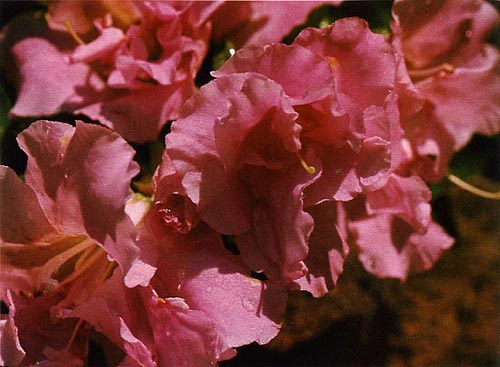
|
|
R. 'Betty Ann Voss'
Photo by Frank Arsen |
'BETTY ANN VOSS' : ('Louise Gable' x 'Tama-giku') x 'Shinnyo-no-tsuki'. Light pink (RHS 62A varying to 62C), 3" hose-in-hose double flowers; blooms late May to early June. Plant habit broader than tall, actually a compact, free branching mound, with beautiful dark green, foliage. A very heavy flowering cultivar, when in full bloom leaves very little to be desired. (U 178).
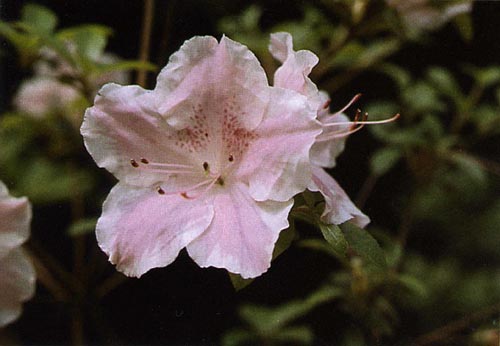
|
|
R. 'Conversation Piece'
Photo by Emil Hager |
'CONVERSATION PIECE'
: ('Emil Rosseau' x Gable cv. 'Carol') x 'Eikan'. Light pink (RHS 68C), 3½" single flowers with lighter margins; some flowers with heavy dotting of red (RHS 57B) in blotch area, other flowers with pink sectors, and/or blotch; blooms late May and early June. Mounded growth habit; responds well to, and should be pinched and shaped as a young plant. A very variable cultivar, very aptly named. (T 36-6: Effie Bunce).
'DOROTHY HAYDEN':
[('Glacier' x ('Louise Gable' x Gable C8G)] x 'Getsu Toku'. White with pale green throat (RHS 149D), 3½" single, flat faced flowers; blooms in early June. A dwarf growth habit; growing about three times as broad as it does tall. (T5-2).
'DOROTHY REESE'
: 'Glacier' x ('Louise Gable' x 'Tama-giku'). White with pale green throat (RHS 145D), 3¼" single flowers with overlapping lobes and wavy margins; blooms late May to early June. A fast growing, free branching, mounded growth habit; very lush, bright green foliage. This cultivar will require more garden space than most Robin Hill Hybrids. (V1-9).
'EARLY BENI'
: [('Louise Gable' x ('Oakland' x Belgian Hybrid)] x Gable cv. 'Carol'. Pale scarlet (RHS 43B), 2½" hose-in-hose double flowers; blooms in early May. Upright semi-dwarf growth habit. Flowers somewhat similar to the Macrantha cv. 'Beni-Kirishima'. (N262).
'EUNICE UPDIKE'
: 'Louise Gable' x 'Shinnyo-no-tsuki'. Pale scarlet (RHS 43 C), 2 to 2½" hose-in-hose double flowers; blooms late May and early June. Dwarf, mounded growth; very free branching and very floriferous, with very glossy elliptic foliage. (U22-2; Mrs. Updike).
'GLAMORA'
: ('Louise Gable' x 'Tamagiku') x 'Wako'. Pale lavender pink, 3" single, occasionally semi-double, flat faced flowers; blooms late May and early June. Very dense, semi-dwarf rounded growth habit. (V21-1).
'GLENCORA'
: 'Shinnyo-no-tsuki' x ('Louise Gable' x 'Tamagiku'). Light red (RHS 47C) 2½" double flowers; blooms early June. Dwarf, broad growth habit. V5-1).
'GRETA'
: [('Oakland' x (Belgian Hybrid x Gable cv. 'Carol')] x 'Getsutoku'. Dark pink (RHS 58C), 3" single flowers with wavy margins; blooms mid to late May, Low, mounded, free branching growth habit. (T13-8).
'GWENDA'
: ('Louise Gable' x 'Tamagiku') x 'Eikan'. Pale pink (RHS 56B), single flowers with wavy margins: blooms in early June. Plant habit semi-dwarf, mound shaped. (T37-4).
'LADY LOUISE'
: 'Louise Gable' x 'Tamagiku'. Pink (RHS 48C), 3" single flowers with slightly darker blotch (RHS 51A); flowers flat faced and occasionally semi-double; blooms in late May. Broad, mounded, compact growth habit, and yet a strong growing plant that will eventually need room to sprawl out and show the flowers to advantage; beautiful, dark green foliage, glossy. (J44-7).
'LADY ROBIN'
. ('Glacier' x 'Tama-giku') x 'Getsu-Toku'. White 3½" single flowers that vary considerably as to amount of dark pink (RHS 66B) stripes and sectors; some flowers will be white with a pale pink wash, or pale pink with an almost white margin, all with or without stripes and sectors; blooms late May and early June. Light green foliage, and broad, sprawling growth habit. (T14-10).
'LAURA MORLAND'
: ('Louise Gable' x 'Tama-giku') x ('Kaigetsu' x Gable cv. 'Carol'). Light pink (RHS 49B), 2½" semi-double flowers with occasional darker stripes (RHS 49A); blooms in late May and early June; Compact, rounded growth habit. Very glossy foliage with a maroon tint that is very striking. (U4-1; Mrs; MORLAND).
'MRS. EMIL HAGER'
: ('Louise Gable' x 'Tama-giku') x 'Shinnyo-no-tsuki'. Bright pink (RHS 68A) 2¾" semi-double to double flowers; blooms in early June. Rounded, heavy branching dwarf growth habit and very glossy foliage. This is considered by many as a "hot pink"; one of the more vibrant flower colors to be seen in the Robin Hill Hybrids. The growth habit, foliage, and flowering characteristics make this cultivar one of the finer Robin Hills. Suitably named for the person who did so much to make the Robin Hills popular. (U14-5; BETTY HAGER).
'NANCY OF ROBINHILL'
: 'Vervaeniana' x ('Louise Gable' x 'Tama-giku'). Light pink (RHS 62C), 3½" hose-in-hose double flowers, with occasional light red blotch; blooms in mid to late May. Broad growing, with free branching growth habit. Beautiful in all respects; words cannot describe this cultivar. Named for Bob Gartrell's wife, he considers this his finest azalea. When I recently asked him which cultivar did he think to be the best of all the Robin Hills, he answered with one word; 'NANCY'. (046-3).
'PAPINEAU'
: 'Glacier' x 'Swansong'. White 3½" flowers with pale green throat, and wavy margins; blooms in late May. Very large leaves, 2½" long and almost 1½" wide; very rich green. A large, fast growing, very beautiful cultivar. Perhaps the largest growing of the Robin Hills; certainly the fastest. (R8-5).
'REDMOND'
: ('Louise Gable' x 'Tamagiku') x 'Heiwa'. Pale scarlet (RHS 39B), 3" flat faced flowers, with conspicuous dotting of rosy red (RHS 47B) on dorsal lobes; blooms in late May and early June. Very dense, mounded, dwarf growth habit, and large dark green round leaves make this a superb garden specimen with year around interest. The pale scarlet flowers, accented by the red spotting create a most unusual effect. (T21-1).
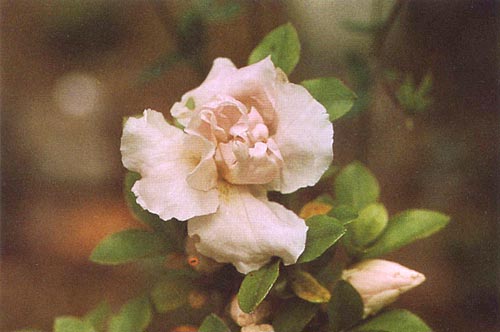
|
|
R. 'Robin Hill Gillie'
Photo by Frank Arsen |
'ROBIN HILL GILLIE' : 'Oakland' x [(Belgian hybrid x Gable cv. 'Carol') x 'GetsuToku')]. Pale orange-red (RHS 42C), 3½" single flowers with wavy margins; blooms in late May. Semi-dwarf, mounded growth habit. (T13-6; GILLIE).
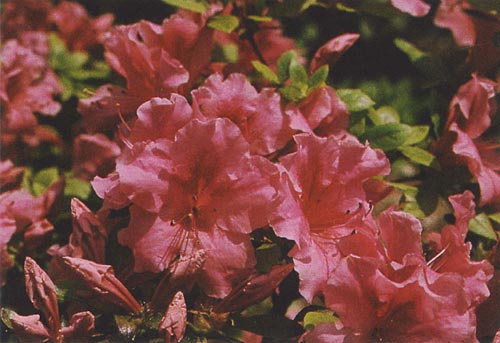
|
|
R. 'Robin Hill Frosty'
Photo by Emil Hager |
'ROBIN HILL FROSTY'
. 'Oakland' x [(Belgian hybrid x Gable cv. 'Carol') x ('Louise Gable' x 'Tama-giku')]. Bright pink (RHS 62A), 2¾" single flowers with distinct dark pink blotch (RHS 55A), and lighter petal edge (RHS 62D), and very wavy margins; blooms in mid to late May. Plant habit mounded, slightly upright; very free branching and semi-dwarf. A very unique flowering appearance, since the lighter pink margin is just a very thin line along the margin edge, not a band, and almost appears to be white, giving the flower a frosted appearance. The very wavy margins make the flower appear larger than they actually are, and amplifies the frosted appearance. This is a very heavy blooming cultivar. Combined with the good growth habit, the flowering qualities make it one of the best of the Robin Hills. (N31-9; FROSTY).
'SPINK'
: Parentage unknown. Bright pink (RHS 62A) 1½" hose-in-hose flowers; blooms early to mid May. Semi-dwarf, compact, slightly upright growth habit. (K 34-3).
'WATCHET':
Amagassa x (Louise Gable x Tama-giku). Light pink (RHS 49B), 3½" single flowers with slightly ruffled margins; blooms in late May. Dense, mounded, semi-dwarf plant habit. (T28-10).
'WHITE MOON'
: ('Glacier' x ''Tamagiku) x 'Getsu Toku'. White 3½" single flowers with a pale green wash (RHS. 149D) in the blotch area, and occasional stripes and/or sectors of pale scarlet (RHS 43C); some flowers will be one third to one half scarlet sector, the remainder pure white; blooms in early June. Beautiful bright green glossy leaves give an ideal background for the unusual flowers. Plant habit mounded, branching nicely; but somewhat loose, which tends to show flowers to good advantage. (T17-7).
Following are the Robin Hill azaleas that have been named but not registered with the ARS. Hopefully the better and most popular of these cultivars will be submitted for registration by Mr. Gartrell, so some names may be altered to conform with requirements of the International Code of Nomenclature of Cultivated Plants - 1969.
'BLUE TIP'
: ('Malvatica' x unknown*) X 'Hosei'. Lavender 2-2½" single flowers; blooms in mid June. Mature plants will have a varying amount of flowers with white centers, enhancing the color and giving a blue appearance. (Z12-2).
'BOB WHITE'
: 'Oakland' X 'Dr. Bergmann'. White 2" single, hose-in-hose flowers, with occasional semi-double or double flowers; blooms mid to late May. The flowers' buds are pale green as they are about to open but, when fully open, the flowers are pure white with just a pale green blotch. Good petal texture adds to the brilliance of the flowers, and the beautifully-shaped corolla is mirrored by the hose-in-hose flower structure. If I were restricted to planting a single white azalea in my garden, it would be this one. Beautiful foliage and mounded growth habit complete the picture. (N42-6).
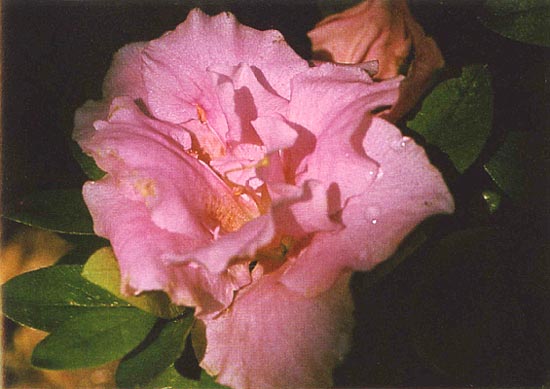
|
|
R. 'Chanson'
Photo by Frank Arsen |
'CHANSON'
: ('Louise Gable' x 'Tamagiku') X 'Shinnyo-no-tsuki'. Pink (RHS 55B), 3" semi-double to double flowers; blooms in early June. Very broad petals create an unusual flowering appearance; broad, mounded growth habit. (U 17-3).
'ELIZA SCOTT'
. 'Oakland' X 'Heiwa'. Pink (RHS 62A), 3" single flowers; blooms in late May and early June. A loose, somewhat upright, mounded growth habit. This cultivar will demand more room than most Robin Hills to be at its best. As with many azalea cultivars with a kaempferi hybrid as a parent, this cultivar cannot be appreciated as a young plant since it has the faculty of forming a cluster of five or six flower buds at the terminal tips when well established in the garden. At this point, the growth habit is of little consequence when the size of flowers and floriferousness is considered. (T23-4).
'JEANNE WEEKS'
: ('Louise Gable x 'Tama-giku') X ('Kaigetsu' x Gable cv. 'Carol'). Light pink (RHS 65A), fully double 2" flowers; blooms in late May. Very beautiful as the flowers resemble rosebuds when opening, and the free branching, compact mounded habit shows the flowers to great advantage. Considered by many who grow the Robin Hill Hybrids to be one of the finest of the group. (U7-8).
'MME. MAB CHALON'
: ('Glacier' x 'Tama-giku') X 'Getsu Toku'. Pale lavender (RHS 65C), 3½" single flowers with occasional light purple stripes and splashes; blooms in late May. Good flower texture; strong growing, mounded habit. Very handsome foliage; large, round, dark green leaves that take on a dark burgundy tint in autumn make this a cultivar to consider when looking for summer texture and fall interest in the garden. (T16-7).
'MRS. VILLARS'
: 'Oakland' X Heiwa'. White 3" single flowers; blooms in early June. Very ruffled petals and occasional pink splashing add interest; mounded growth habit. (T23-10).
'ORMSBY'
: 'Louise Gable' X 'Yozakura'. Pale red (RHS 39A) fully double, 2½" flowers; blooms in late May. Very free branching, dense upright growth habit; growing slightly broader than tall and very heavy flowering. (T45-3).
'PEG HUGGER'
: ('Louise Gable' x 'Tama-giku') X ('Kaigetsu' x Gable cv. 'Carol'). Pale pink (RHS 49A), 2½" double flowers; blooms in mid May. Compact, mounded habit. (Ul-8).
'PETER POOKER'
: ('Louise Gable' x 'Tama-giku') X 'Shinnyo-no-tsuki', Lavender THS 73C), 2¾" single flowers; blooms in early June. Very ruffled flowers, with broad petals make the flowers appear larger; when in bud almost promises to open light purple, giving some contrast against the already open flowers. Low, broad, semi-dwarf growth habit; dark green foliage, best described as lush, makes a perfect backdrop for the flowers. Lavender is a color many people overlook when considering azaleas. Some consider it lifeless, others funeral, and still others just look at lavender as a poor relation of purple. However, I think this cultivar may change many a mind. (U15-1).
'PULKEN'
: Belgian Hybrid X Gable cv. 'Carol'. Purple (RHS 67A), 2¼" single hose-in-hose flowers; blooms in late May. Flowers are very flatfaced and ruffled. Mounded growth habit. (T626).
'ROBIN DALE'
: 'Oakland' X 'Heiwa'. White 3½" single flowers with pale green throat; blooms mid to late May Very ruffled margins, and occasional semi-double to double flowers, with some pale red splashing add interest. Somewhat open, broad, mounded growth habit. (T24-8).
'SARA HOLDEN'
: 'Oakland' X 'Heiwa'. White 3" single flowers; blooms in late May. A dense compact mounded growth habit; light green foliage that remains fresh-looking on the hottest summer day, and flowers with ruffled margins that have light red splashing and stripes make this a very worthwhile cultivar. (T22-5).
'SIR ROBERT'
. ('Glacier' x 'Tamagiku') X 'Getsu Toku'. Very pale pink (RHS 55D), with righter center; 3¾" single, somewhat flat-faced flowers, with occasional flowers all white with pale pink sectors, or stripes; or pale pink flowers with white sectors, or sometimes all white flowers. Very variable; all the flower patterns may appear on just several branches, or the entire plant. Blooms during June, occasional flowers may start blooming in late May. Blooming is almost sparse at times, and then suddenly very heavy blooming, and then slowing down again, affording bloom over a four to five-week period. Of course, this length of blooms is dependent on optimum weather conditions during June. One is almost teased, or bewitched, as each flower opens to reveal the different color patterns. With the different patterns, all in soft pink and white 'Sir Robert' has a flowering effect unique among hardy evergreen azaleas. The habit of growth is ideal; dense, compact, semi-dwarf. Very dark green foliage that appears crisp and clean is a perfect backdrop for the soft color tones of the flowers. (T15-8).
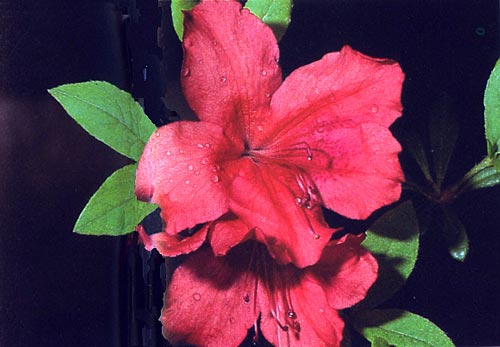
|
|
R. 'Turk's Cap'
Photo by Emil Hager |
'TURK'S CAP'
: Parentage unknown. Bright scarlet-red 3¼" single flowers; blooms in late May. A loose, upright growth habit indicates that possibly 'Oakland' is one of the parents. The large flowers sometimes have recurving petals that resemble a Turkish-style cap, hence the name 'Turk's Cap'. This is not consistent from year to year, however. (T60-6).
'VERENA'
: 'Oakland' X 'Tams Giku'. Lavender 2½" single flowers, with a slightly lighter throat; blooms in late May. Fast-growing, mounded growth habit. (T49-4).
'WEE WILLIE'
: 'Shinnyo-no-tsuki' X ('Louise Gable' x 'Tama-giku'). Light pink (RHS 38B), 2¾" single flowers with lighter throat; blooms in early June. Dense, compact, semi-dwarf growth habit; perhaps the slowest growing of the Robin Hill hybrids that have been named. Bob Gartrell has had second thoughts about the name given this cultivar, however. He feels that any cultivar name using the adjective "wee" should be truly diminutive in habit. 'Wee Willie' may not stay as small as the name may imply, but it is still a very beautiful flowering plant. The flowers are a very delicate shade of pink, and having broad ruffled petals adds to their charm. The habit of growth, being very dense, makes each flower bud compete for space to open, so at flowering time the small plant is just smothered with beautiful pink flowers. (V2-10).
'WELMET'
: 'Oakland' x 'Helwa'. Lavender-pink (RHS 65A), 3¾" double flowers. Slightly loose, broad, mounded growth habit. (T25-5).
'WENDY'
: ('Louise Gable' x 'Tamagiku') x 'Helwa'. Light pink (RHS 38B), 3" single flowers with wavy margins; blooms in mid June. Compact, mounded growth habit. (T21-3).
'WHITE HART'
('Gumpo' x 'Glacier') x 'Snowclad'. White 3¼" single flowers with green blotch and ruffled margins; blooms in late May. This is an unusual hybrid in the respect that all the parents are usually on lists of recommended white azaleas. Each parent is a superb white azalea, and 'White Hart' certainly shows their fine qualities in flower; however, it has a stiff, mounded habit, and foliage that has a wrinkled appearance. These two slight drawbacks dominate the garden appearance just enough to keep 'White Hart' from being the best white Robin Hill Hybrid. (J 12-1).
'WHITE HEAD'
: 'Glacier' X 'Getsu Toku'. White 3" single flowers; blooms in early June. Somewhat loose, mounded growth habit. (T2-4).
UNNAMED ROBIN HILL HYBRIDS
Following are some Robin Hill hybrids that have been grown by members of the New York Chapter Azalea Study Group, and in spite of being unnamed, have become favorites of many of the members.
H19-9
: 'Jimmy Coover' x 'Glamour' Bright red (RHS 42A), 2" double flowers; blooms in late May and early June. Dense, semi-upright, broad compact growth habit; small elliptic to slightly-oblanceolate leaves that turn maroon in autumn. Both parents are hybrids of
Azalea indicum
, and the fine foliage and growth habit qualities have been inherited by this Robin Hill Hybrid.
N26-2
: ('Louise Gable' x 'Oakland') X (Belgian hybrid x Gable cv. 'Carol'). Dark pink (RHS 39A), 2½" double flowers; blooms in late May. Compact, semi-dwarf mounded growth habit.
N33-2
: (Belgian hybrid x 'La Lumiere') X (Belgian hybrid x 'La Lumiere'). Bright scarlet (RHS 44A), 2¼" single flowers; blooms in late May. Broad, compact growth habit; beautiful glossy foliage that turns deep maroon in autumn. This is just about the most vibrant flower color in the Robin Hill hybrids. Combined with the very striking foliage and good growth habit, it makes a superb garden plant.
P4-7
: ('Mary' x 'Beacon') x ('June Dawn' x ' Macrostemon'). Light pink (RHS 39C), 1½" hose-in-hose flowers, with occasional double flowers; blooms in late May. Slightly upright, compact mounded growth habit.
P25-6
.' Parentage unknown. Pink (RHS 39C) 2" hose-in-hose flowers; blooms in mid to late May. Mounded growth habit. Beautiful flower form with sharp margins, which are enhanced by the hose-in-hose structure and deeper pink stripes (RHS 39B) with a lighter throat make this variety outstanding. The striping is not very definite; almost a gradation of the color tone, as if an artist has taken his brush and palette and touched up the flowers. Very unusual, and needless to say, a very beautiful garden subject.
T15-7
: ('Glacier' x 'Tams-giku') X 'Getsu Toku'. Pink (RHS 49A), 3¼" single flowers; blooms in mid June. Very broad and ruffled petals; flat-faced flowers with the petals having a slight backwards curling create a very unusual flowering appearance. Nice, mounded growth habit.
T17-5
: ('Glacier' x 'Tams-giku') X 'Getsu Toku'. Light pink (RHS 38B), 3¼" single flowers with very ruffled petals; blooms in mid June. Handsome glossy foliage and low some what sprawling growth habit.
T18-3
: ('Treasure' x
Az. mucronatum
seedling) X 'Getsu Toku'. Light pink (RHS 39D), 2¾" single flowers with very broad petals; blooms in mid June. Broad, mounded growth habit. V12-4: ('Jimmy Coover' x 'Glamour') X ('Louise Gable' x 'Tams-giku'). Scarlet (RHS 43B), 2" double flowers; blooms in late May and early June. As with Robin Hill hybrid #H19-9, the
Az. indicum
traits are evident in the foliar characteristics and growth habit. There are numerous other Robin Hill hybrids being grown under number; propagated, exchanged, and admired by New York Chapter Azalea Study Group members. These unnamed selections are not to be considered inferior to the named cultivars. Bob Gartrell has named those selections that met his own personal standards, and has also tried to keep the number of named varieties within reason. Currently, there are two groups of unusual Robin Hill hybrids being propagated: dwarf forms that arose from witches'-broom growths, and dwarf hybrids from Bob Gartrell's crosses. This latter group are plants that are ten to twelve years old, and measure only about 10 inches high, and are over 2 feet in spread. There are several others that Bob Gartrell has selected for naming and registration. When they have been formally registered with the ARS, they will be described along with the dwarfs in a future article.
* unknown, or when stated as parentage unknown, refers to a common problem with gardeners: a lost or illegible label.
